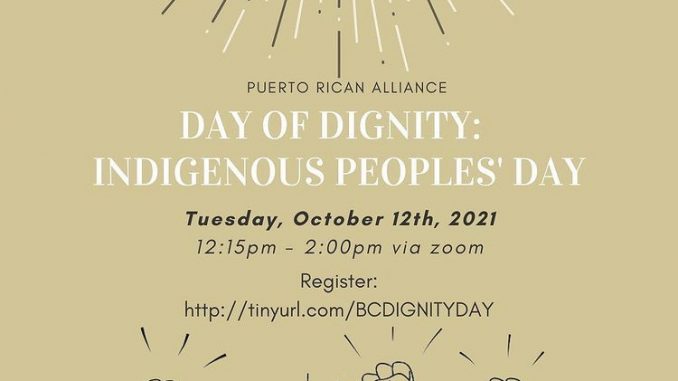
By Gabriela Flores
In commemoration of Indigenous Peoples Day, Brooklyn College’s Puerto Rican Alliance (PRA) gave an overview of indigenous history last Tuesday, Oct. 12. There, participants and the PRA hosts Christopher Arias and Valeria Pinet delved into Taíno culture predating Columbus’ arrival, the complexities of identity, colonialism, and other aspects that have affected North American and Caribbean indigenous peoples throughout history.
“We respect and acknowledge that indigenous people are the original stewarts of this land, and continue to be despite past and present continuation of forced removal from their traditional territories at the hands of colonial settler states like the US,” said Pinet, acknowledging that the land that makes New York City belongs to the Lenape and Canarsee indigenous people. “It’s important that we see indigenous people for who they are today. From resilient to thriving to creative and inspiring,” she continued.
In starting their observance of the holiday that celebrates Native Americans and other indigenous people, while rejecting the recognition of Christopher Columbus Day, the PRA debriefed the history of Lenapehoking, or “land of the Lenape.” Pinet informed participants that New York City, some southern counties of the state, New Jersey, and parts of Pennsylvania and Delaware exist on Lenape land stolen by colonizers. To date, Lenape history has shaped the landscape of the Big Apple, Pinet explained. Before becoming the financial hub it is today, Wall Street in the 17th century, for example, was where a 12-foot wall was designed to keep native Lenape people out of what is Manhattan today.
Across the waters and into what we now call the Caribbean, encompassing major islands like Puerto Rico and Cuba, the indigenous Taíno lived and organized into chiefdoms, a structure where one designated leader looked over several communities. Interestingly, host Arias said, chiefs in Taíno culture could have been men or women – and family lineage was traced through the mothers of these communities.
“So there was a very strong sense of motherhood and mother wisdom that guided them,” said Arias.
Though there are no records on how many Taínos lived in what was then known as Hispaniola, about 3 million were recorded when Columbus arrived on its shores. They were skilled in abilities like sailing and navigating, actively venerated their ancestors, and were spiritually in tune with their environment, gods, and goddesses. But by 1565, after Columbus invaded, they were declared “extinct” under a census that their descendants today call “paper genocide,” an attempt to erase records of the culture’s existence, Arias explained.
“We have to put into context to understand that a lot of these documents such as the census I referred to were created by the colonizers – so there’s very much biased perspective on how information is gathered,” said Arias. “It’s important to have that context and lense to understand things better.”
Today, about 61 percent of Puerto Ricans were found to be American Indian through mitochondrial DNA, which is genetic information that descends from the mother. Many Boricuas commonly think that their indigenous ancestry is linked to the Taínos, according to a video the hosts showed to detail further how deep-rooted Taíno history is beyond documents safe kept by colonialists.
Given the biases seeped into historical records about the Taíno, and other indigenous people, the PRA hosts emphasized the importance of researching these cultures and colonialism through different perspectives.
“I think it’s also important to realize the process of colonialism both past and present because it’s important to remember that colonialism has no specific time period,” Pinet said. She quoted historian Patrick Woolfe from his discussion of “settler colonialism,” the concept of a settler having the intention to make the land they invaded their permanent home.
More broadly, colonialism encompasses military force; internal efforts, such as cultural assimilation; and other practices of subjugation against native people. The process of decolonization, which would differ between settler states like the U.S., would call for getting rid of “settler sovereignty,” a concept Pinet referenced from the article “Decolonization Is Not A Metaphor.”
Through actions like land reparation, which call for the recognition of stolen lands and the significant role indigenous people play in protecting biodiversity, one could better understand the history of native people.
“This presentation barely scratches the surface of the erasure of both North American and indigenous peoples history,” Pinet said in closing, “and so we urge and encourage you all to support indigenous creators and organizations that continuously exemplify their resilience and strength.”
